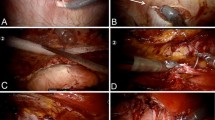Abstract
To compare retromuscular and preperitoneal mesh positioning in open ventral hernia mesh repair, we performed a retrospective and comparative study of patients who underwent retromuscular mesh repair (RMMR) and preperitoneal mesh repair (PPMR) for ventral abdominal hernias between January 2012 and December 2016. We used propensity score matching to adjust for potential baseline confounders between two groups. After propensity score matching, 68 patients who underwent RMMR were compared with 92 patients treated with PPMR. There was no difference between RMMR and PPMR regarding operative time (85.24 vs 65.34 min, p = 0.120), drainage duration, hospital stay (3.12 vs 1.7 days, p = 0.226), morbidity (20.5% vs 11.9%, p = 0.129), superficial abscess (p = 0.056), deep abscess (p = 0.188), hematoma (p = 0.220), and seroma (p = 0.593). PPMR was superior to RMMR in term of drainage rate, drainage quantity (128 ml vs 36 ml, p = 0.001), drainage duration (3.6 vs 4.14 days, p = 0.068), and re-hospitalisation rate (7 vs 1 patient, p = 0.011). The mean follow-up in RMMR group was 42.6 months and 35.9 months in PPMR group. Nineteen patients were lost in follow-up (10.3%). Median delay of recurrence was 20.3 months in RMMR group and 11.1 months in PPMR group. At 3-year follow-up, there was no statistically difference between the two groups regarding the recurrence (11 vs 9 patients, p = 0.33) and delay of recurrence (20.3 vs 11.1 months, p = 0.175). RMMR and PPMR present a good alternative for open sublay mesh repair. They are safe, efficient, and associated with comparable complication and recurrence rates.



Similar content being viewed by others
References
Holihan JL, Hannon C, Goodenough C, Flores-Gonzalez JR, Itani KM, Olavarria O, Mo J, Ko TC, Kao LS, Liang MK (2017) Ventral hernia repair: a meta-analysis of randomized controlled trials. Surg Infect 18:647–658
Muysoms FE, Miserez M, Berrevoet F, Campanelli G, Champault GG, Chelala E, Dietz UA, Eker HH, el Nakadi I, Hauters P, Hidalgo Pascual M, Hoeferlin A, Klinge U, Montgomery A, Simmermacher RK, Simons MP, Smietański M, Sommeling C, Tollens T, Vierendeels T, Kingsnorth A (2009) Classification of primary and incisional abdominal wall hernias. Hernia 13:407–414
Arroyo A, García P, Pérez F, Andreu J, Candela F, Calpena R (2001) Randomized clinical trial comparing suture and mesh repair of umbilical hernia in adults. Br J Surg 88:1321–1323
Mathes T, Walgenbach M, Siegel R (2016) Suture versus mesh repair in primary and incisional ventral hernias: a systematic review and meta-analysis. World J Surg 40:826–835
Winsnes A, Haapamäki MM, Gunnarsson U, Strigård K (2016) Surgical outcome of mesh and suture repair in primary umbilical hernia: postoperative complications and recurrence. Hernia 20:509–516
Holihan JL, Nguyen DH, Nguyen MT, Mo J, Kao LS, Liang MK (2016) Mesh location in open ventral hernia repair: a systematic review and network meta-analysis. World J Surg 40:89–99
Schumpelick V, Klinge U, Junge K, Stumpf M (2004) Incisional abdominal hernia: the open mesh repair. Langenbeck’s Arch Surg 389:1–5
Burger JW, Luijendijk RW, Hop WC, Halm JA, Verdaasdonk EG, Jeekel J (2004) Long-term follow-up of a randomized controlled trial of suture versus mesh repair of incisional hernia. Ann Surg 240:578–585
Hawn MT, Gray SH, Snyder CW, Graham LA, Finan KR, Vick CC (2011) Predictors of mesh explantation after incisional hernia repair. Am J Surg 202:28–33
Iqbal CW, Pham TH, Joseph A, Mai J, Thompson GB, Sarr MG Long-term outcome of 254 complex incisional hernia repairs using the modified Rives-Stoppa technique. World J Surg 31:2398–2404
Singhal V, Szeto P, VanderMeer TJ, Cagir B (2012) Ventral hernia repair: outcomes change with long-term follow-up. JSLS 16:373–379
Rogmark P, Smedberg S, Montgomery A (2018) Long-term follow-up of retromuscular incisional hernia repairs: recurrence and quality of life. World J Surg 42:974–980
Le H, Bender JS (2005) Retrofascial mesh repair of ventral incisional hernias. Am J Surg 189:373–375
Novitsky YW, Porter JR, Rucho ZC, Getz SB, Pratt BL, Kercher KW, Heniford BT Open preperitoneal retrofascial mesh repair for multiply recurrent ventral incisional hernias. J Am Coll Surg 203:283–289
Stoppa RE (1989) The treatment of complicated groin and incisional hernias. World J Surg 13:545–554
Gleysteen JJ (2009) Mesh-reinforced ventral hernia repair: preference for 2 techniques. Arch Surg 144:740–745
Langer C, Schaper A, Liersch T, Kulle B, Flosman M, Füzesi L, Becker H (2005) Prognosis factors in incisional hernia surgery: 25 years of experience. Hernia 9:16–21
Millikan KW (2003) Incisional hernia repair. Surg Clin North Am 83:1223–1234
Schumpelick V, Conze J, Klinge U (1996) Preperitoneal mesh-plasty in incisional hernia repair. A comparative retrospective study of 272 operated incisional hernias. Chirurg 67:1028–1035
Petro CC, Posielski NM, Raigani S, Criss CN, Orenstein SB, Novitsky YW (2015) Risk factors for wound morbidity after open retromuscular (sublay) hernia repair. Surgery 158:1658–1668
Author information
Authors and Affiliations
Corresponding author
Ethics declarations
Conflict of Interest
The authors declare that they have no conflict of interest.
Ethical Approval
Respected.
Additional information
Publisher’s Note
Springer Nature remains neutral with regard to jurisdictional claims in published maps and institutional affiliations.
Rights and permissions
About this article
Cite this article
Dougaz, M.W., Chaouch, M.A., Cherni, S. et al. Preperitoneal Versus Retromuscular Mesh Repair for Ventral Abdominal Hernias: A Propensity Matched Analysis. Indian J Surg 82, 868–873 (2020). https://doi.org/10.1007/s12262-020-02153-7
Received:
Accepted:
Published:
Issue Date:
DOI: https://doi.org/10.1007/s12262-020-02153-7




